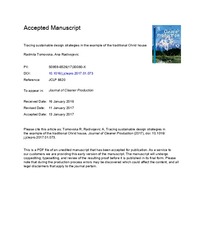Prikaz osnovnih podataka o dokumentu
Tracing sustainable design strategies in the example of the traditional Ohrid house
| dc.creator | Tomovska, Radmila | |
| dc.creator | Radivojević, Ana | |
| dc.date.accessioned | 2019-11-03T15:57:19Z | |
| dc.date.available | 2019-01-18 | |
| dc.date.available | 2019-11-03T15:57:19Z | |
| dc.date.issued | 2017 | |
| dc.identifier.issn | 0959-6526 | |
| dc.identifier.uri | https://raf.arh.bg.ac.rs/handle/123456789/399 | |
| dc.description.abstract | This paper examines the sustainable design strategies of the Balkan vernacular architecture in the example of the traditional Ohrid house. The approach regarding the problem of resource conservation which is present in the selected examples of vernacular architecture offers the possibility of analysing and discussing the building strategies of the past, which are still considered to be relevant in terms of sustainability and environmental design. The subject of this research is the sustainable design strategies that refer to the reuse of building material and the measures regarding waste reduction in the form of its incorporation into new building materials. The research points to sustainable solutions regarding on-site minimisation of construction waste in the example of the traditional Ohrid hobse during the following three phases of the life cycle of both the material and the building: pre-building, building, and post building phase. The applied on-site waste minimisation measures and the principle of using materials with low-embodied energy, identified in the example of the traditional Ohrid house, can be understood as the conceptual basis for finding more efficient solutions in today's material and energy conservation practices, proving that sustainable architecture could be achieved by a simple and thoughtful application of local materials and building techniques. | en |
| dc.publisher | Elsevier Ltd | |
| dc.rights | embargoedAccess | |
| dc.rights.uri | https://creativecommons.org/licenses/by-nc-nd/4.0/ | |
| dc.source | Journal of cleaner production | |
| dc.subject | Ohrid's vernacular architecture | en |
| dc.subject | On-site waste minimisation | en |
| dc.subject | Reuse | en |
| dc.subject | Sustainable design strategies | en |
| dc.subject | Traditional Ohrid house | en |
| dc.title | Tracing sustainable design strategies in the example of the traditional Ohrid house | en |
| dc.type | article | |
| dc.rights.license | BY-NC-ND | |
| dcterms.abstract | Томовска, Радмила; Радивојевић, Aна; | |
| dc.citation.volume | 147 | |
| dc.citation.spage | 10 | |
| dc.citation.epage | 24 | |
| dc.citation.rank | aM21 | |
| dc.description.other | This is the peer-reviewed version of tha manuscript: Tomovska, Radmila, and Ana Radivojević. 2017. ‘Tracing Sustainable Design Strategies in the Example of the Traditional Ohrid House’. Journal of Cleaner Production 147 (March): 10–24. [https://doi.org/10.1016/j.jclepro.2017.01.073] | |
| dc.identifier.wos | 000395602600002 | |
| dc.identifier.doi | 10.1016/j.jclepro.2017.01.073 | |
| dc.identifier.scopus | 2-s2.0-85013671910 | |
| dc.identifier.fulltext | https://raf.arh.bg.ac.rs/bitstream/id/768/tomovska2017.pdf | |
| dc.type.version | acceptedVersion |

